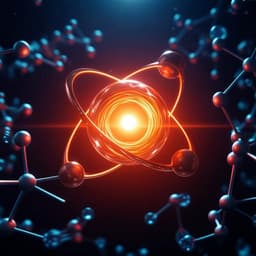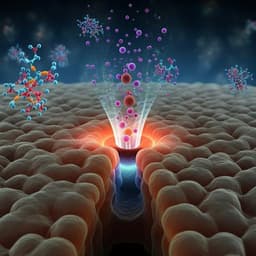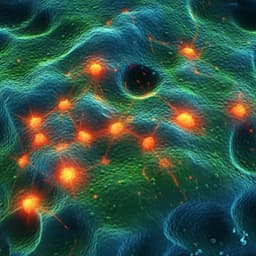
Medicine and Health
Single-atom nanozymes catalytically surpassing naturally occurring enzymes as sustained stitching for brain trauma
S. Zhang, Y. Li, et al.
Discover the groundbreaking advancement in catalysis with the development of single-atom nanozymes exhibiting exceptional catalytic activities, outpacing natural enzymes. Led by Shaofang Zhang and colleagues, this research showcases these nanozymes' remarkable stability and recyclability, paving the way for enhanced biomedical applications like accelerated scalp healing after brain trauma.
Playback language: English
Introduction
Artificial enzyme engineering with sustainabilities emerges as a versatile methodology for creating biocatalysts. The intrinsic feature of continuous electron transfers allows artificial enzymes to maintain high catalytic stability and arbitrarily tailor their characteristics. The superior catalytic activity over the naturally-occurring enzymes is one of the major challenges existing in designing artificial enzymes. A feasible strategy is to construct an artificial active center by imitating the biologically active center of enzymes or proteins. As a fast-growing category of artificial enzymes, the emerging nanozyme can actively tailor biocatalytic activities and selectivity via its flexible atomic structures and molecular engineering. State-of-art nanozymes with an M-N4 center inspired by cytochrome P450 have superior reaction rates and high substrate affinities close to the natural horseradish peroxidase (HRP). Expanded Fe-N5 and Fe-N3-P were reported to have 17- and 2-fold higher catalytic efficiencies than Fe-N4, indicating their great potential in boosting bioactivities. However, the development of nanozymes with properties outperforming natural enzymes remains unfulfilled and highly challenging. Other unresolved and high-profile questions are the underlying reaction mechanisms and detailed atomic coordination structures during biocatalytic reactions to endow catalytic selectivity. Unlike the well-defined structures of single-atom catalysts, traditional nanostructures without elucidated atomic structures on the surface cannot provide sufficient structure–function correlation to study the electron transfers at atomic levels. For example, Pt and Fe3O4 exhibit peroxidase-like (POD-like) activities; Au and V2O5 are more selective for the glutathione peroxidase-like (GPx-like) activity; Cu demonstrates a superior superoxide dismutase-like (SOD-like) activity. However, the selectivity of these biocatalysts merely relies on the specific atomic coordination and surface ligands of individual nanosystems, making it difficult to corroborate a universal catalytic mechanism explicitly. Besides, the complexity of reaction pathways also compromises catalytic reactions of nanozymes, leaving the atomic configuration and bond morphology inadequately clarified during the dynamic reaction process. In this work, we report structurally well-defined and atomically precise biocatalysts of RhN4 and VN4, with high POD- and catalase (CAT)-like activities, surpassing corresponding natural enzymes and reported FeN4. Moreover, the RhN4 and VN4 favorably form the Rh/V–O–N4 structure as the active center of circular catalytic processes to decrease reaction energy barriers significantly, which is fundamentally different from FeN4. In particular, the catalytic mechanism of RhN4 and VN4 modulates a unique “two-sided oxygen-linked” catalytic reaction path, resulting in high catalytic efficiency. Meanwhile, the specific SOD activity is derived from Fe–Cu–N6, and the GPx-like activity of VN4 considerably exceeds that of the natural GPx. Furthermore, the high catalytic stability and recyclability enable these nanozymes to be used as medical sutures for sustained scalp healing from brain trauma via a serial biocatalytic process. RhN4 and VN4 in sutures play an essential role in the proactive regulation and immune control of macrophages and vascular endothelial growth factors (VEGF).
Literature Review
The introduction section provides a comprehensive literature review of existing nanozymes and their limitations. It highlights the challenges in achieving catalytic activities surpassing natural enzymes and the need for a deeper understanding of reaction mechanisms and atomic coordination structures. The review emphasizes the importance of single-atom catalysts and their well-defined structures in studying electron transfers at atomic levels. It contrasts the selectivity of existing biocatalysts, which often relies on specific atomic coordination and surface ligands, with the desired goal of a more universal catalytic mechanism. The review sets the stage for the current study by pointing out the gap in the field: the lack of nanozymes that demonstrably outperform natural enzymes in their catalytic properties.
Methodology
The MNx (M = Rh, V, Fe, Cu, and Fe–Cu; x = 4 or 6) nanozymes were synthesized via pyrolysis. RhN4 and VN4 preserved the pristine polyhedral structure of zinc-imidazole frameworks (ZIF-8), while Fe–Cu–N6 exhibited an amorphous morphology. Aberration-corrected high-angle annular dark-field scanning transmission electron microscopic (AC-HAADF-STEM) images showed single metal atoms sparsely dispersed in the ZIF-8 framework. Energy-dispersive X-ray spectroscopy (EDS) mapping analysis showed a uniform distribution of single metal atoms and C and N elements. X-ray photoelectron spectroscopy (XPS) identified major nitrogen species as pyridinic, graphitic, and pyrrolic N, while carbon species were primarily composed of graphitic C, C=C–N, and N–C=N. Inductively coupled plasma-mass spectrometry (ICP-MS) investigated the elemental composition of metal-based active sites. X-ray absorption near-edge structure (XANES) and Fourier transformed (FT) extended X-ray absorption fine structure (EXAFS) characterized the atomic coordination structure between metal atoms and neighboring atoms. Density functional theory (DFT) was used to explore the underlying reaction pathways and substantiate the high POD-like catalytic efficiency by investigating various intermediate/transition states of MN4 attached to different chemical units. Electron spin resonance (ESR) spectroscopy was employed to further verify whether MNx can scavenge •OH in an inflammatory physiological environment. The CAT-like activities of MNx were evaluated by monitoring the decomposition of H2O2. Kinetic analysis determined the maximum reaction velocity (Vm) and Km using Michaelis-Menten kinetics. SOD-like activities were studied using the NBT chromogenic approach and the inhibition rate of SOD was verified via the SOD-mimic reaction assay. The GPx-like activity was evaluated using the classic glutathione reductase (GR) coupling assay. Finally, MNx sutures were prepared by integrating MNx into polyglycolic acid (PGA) sutures and applied to mouse models of TBI to study their potential healing effects. Characterization techniques included field-emission scanning electron microscopy (FE-SEM), ICP-MS, XRD, and Raman spectroscopy. In vivo wound healing effects were assessed through wound size measurements, ELISA analysis of cytokines, flow cytometry analysis of macrophages, and immunofluorescence/immunohistochemistry staining.
Key Findings
The study successfully synthesized single-atom nanozymes (RhN4, VN4, and Fe-Cu-N6) with catalytic activities exceeding those of natural enzymes. Rh/VN4 demonstrated a unique "two-sided oxygen-linked" reaction path, resulting in 4-5 times higher peroxidase-like activity than FeN4 and natural horseradish peroxidase. RhN4 exhibited a 20-fold improvement in catalase-like activity compared to natural catalase. Fe-Cu-N6 showed selectivity towards superoxide dismutase-like activity, while VN4 displayed 7 times higher glutathione peroxidase-like activity than natural glutathione peroxidase. DFT simulations revealed that Rh/VN4 preferentially forms the Rh/V-O-N4 structure, significantly decreasing reaction energy barriers and accelerating catalytic kinetics. The high catalytic stability and recyclability of Rh/VN4 sutures were confirmed for over a month. In vivo studies using a mouse model of traumatic brain injury showed that Rh/VN4 sutures accelerated scalp healing by promoting vascular endothelial growth factor (VEGF), regulating macrophages, and diminishing inflammation. The sutures demonstrated efficacy in reducing wound size and inflammation markers (IL-6, IL-1β, TNFα), increasing M2 macrophage polarization, and promoting angiogenesis (CD31). The study's findings showcase the potential of single-atom nanozymes as superior biocatalysts for biomedical applications, particularly in wound healing.
Discussion
This study successfully demonstrated the superior catalytic activity of single-atom nanozymes over their natural counterparts, addressing a significant challenge in artificial enzyme engineering. The discovery of the unique "two-sided oxygen-linked" reaction pathway in Rh/VN4 provides valuable mechanistic insights and highlights the potential for designing even more efficient nanozymes. The successful application of Rh/VN4 sutures in accelerating scalp healing in a mouse model of TBI underscores the translational potential of these nanozymes in addressing clinically relevant problems. The findings suggest that the multifunctional catalytic properties of the nanozymes contribute to their therapeutic efficacy by mitigating oxidative stress, modulating the immune response, and promoting tissue regeneration. This work significantly advances the field of nanozyme-based therapeutics and opens up new avenues for developing highly effective and sustainable biocatalysts for various biomedical applications.
Conclusion
This research successfully developed single-atom nanozymes with catalytic activities surpassing natural enzymes. The unique “two-sided oxygen-linked” reaction pathway of Rh/VN4 was identified as a key factor contributing to its superior performance. The nanozyme-based sutures demonstrated significant efficacy in accelerating scalp healing in a mouse model of TBI. This work opens new avenues for designing advanced biomaterials and therapeutic strategies for treating various injuries and diseases. Future research could focus on exploring other metal combinations and optimizing nanozyme structures to further enhance catalytic activity and selectivity. In vivo studies in larger animal models and clinical trials are warranted to validate the therapeutic potential of these nanozymes.
Limitations
The study primarily used a mouse model of TBI, and the findings may not be directly generalizable to humans. Further investigation is needed to assess the long-term effects and potential toxicity of the nanozymes in vivo. While the mechanism of action was explored using DFT simulations, additional experimental studies might be necessary to fully elucidate the intricate reaction pathways. The study focused on scalp wound healing; future studies should investigate the efficacy of these nanozymes in other tissue types and injury models.
Related Publications
Explore these studies to deepen your understanding of the subject.







